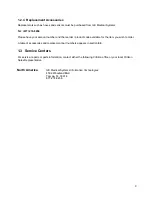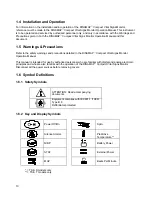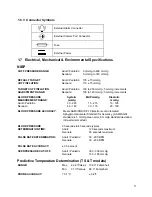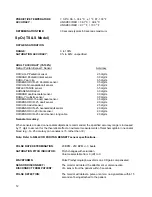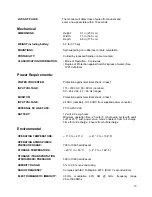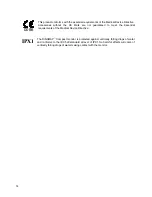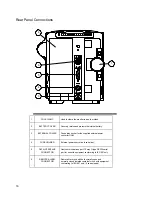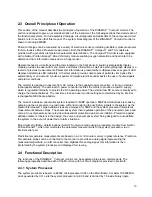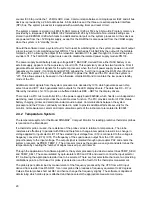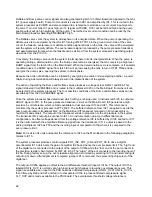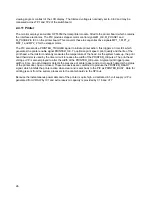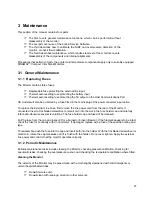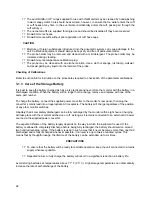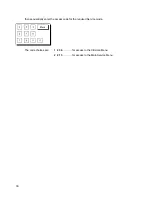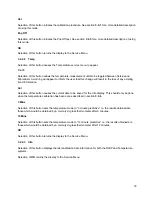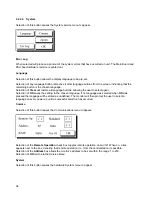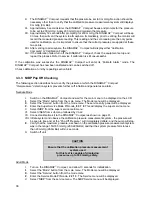
23
buffered by IC12 to produce TH_VREF which can be measured by the system processor via multiplexer
IC20 and ADC IC23.
Upon clearance of the overpressure condition the Main Board system processor can reset the overpressure
latch in GAL IC1 on the PSU Board, by asserting PNEU_RESET signal high, in order that another
determination can be carried out.
2.4.5 SpO
2
System (TS & S models only)
Blood oxygen saturation and pulse determinations can be made (DINAMAP
™
Compact
TS and S only)
using a Nellcor Puritan Bennett
™
finger sensor. This connects to the SpO
2
module fitted inside a shielded
case mounted in the monitor. This module is supplied as a complete replaceable part, no service being
possible.
The SpO
2
module communicates with the system processor via an isolated two wire serial interface. Data
signals from the system processor (SPO2_TX) are isolated by opto-coupler PC6. From here they enter
connector PL13 to the SpO
2
module. Likewise, data transmitted from the SpO
2
module are isolated by opto-
coupler PC5, from where it is routed to the system processor as signal SPO2_RXD.
The SpO
2
module (and the temperature determination circuit) is powered via an isolated power supply
module PM100. This is powered from the +12VV supply and generates the is5VI, +9VI and -9VI
supplies (+5VI, +15VI and -15VI supplies on revision 04 units and earlier). On revision 06 units the isolated
power supply module is switched on by the system processor SPO2_PSU_ON signal, turning TR11 off and
setting the control input to ML3 high. On revision 04 and earlier units the isolated power supply module ML3
is turned on by grounding its -ve supply connection through FET TR12. In the event of a FAILSAFE
condition arising, the control signal of ML3 is set low by TR10 switching on (06 unit), or by switching TR12
off (on revision 04 units and earlier).
2.4.6 Power Supply
The power supplies are generated and controlled on the power supply board.
The power supply is designed to operate from both an external DC line source and from a 12-volt
rechargeable lead-acid battery. The supplied mains power converter provides 24 volt DC output. When both
supplies are present, the power supply will operate from the line supply if it is greater than 12 volts. If the
line supply is greater than 16 volts the battery will be charged both when the monitor is switched on and off.
The power supply sequencing functions are controlled by the PIC IC5.
Incoming line power from the external power converter has any high voltage spikes snubbed by transient
suppresser D4 and over-voltage protection is provided by D6, R10 and CSR1. Should the line input voltage
rise above 34 volts, zener diode D6 conducts, turning on thyristor CSR1. This causes a short circuit which
blows the external DC line fuse. Reverse polarity protection for the power supply is provided by blocking
diodes D8 and D29. A sample of the line input voltage is taken by R3 and R6 (DC_INPUT), and routed to
the external DC detection circuit IC16 and the PIC.
The switcher IC3, inductor L1 and diode D10 form a flyback converter with a nominal output of 15.1 volts
and VRAW of 14.8 volts through the battery blocking diode D11. A sample of the smoothed output is taken
by R29 & R30 to provide a feedback voltage.
The PIC uses the DC_BATTERY, DC_INPUT and EXT_DC_ON signals to determine the available power
sources. If valid power supply conditions exist and a battery is detected, the PIC will turn on TR7, which
turns on p-channel FET TR6, allowing the +15VI line to charge the battery via D9, R17 and FS1. When
charging is taking place, a voltage will appear across R17, which will be proportional to the charge current.
This voltage is sampled by R14 & R15 to produce the BATTERY_C signal.

